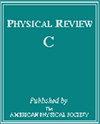Band terminations and maximum spin values with up to 18 aligned particles (and holes) in the Z,N=50 to 82 shells
IF 3.4
2区 物理与天体物理
Q1 Physics and Astronomy
引用次数: 0
Abstract
Observed rotational bands that terminate or appear to terminate at very high spin are analyzed within the configuration constrained cranked Nilsson-Strutinsky (unpaired CNS or CNSB with pairing) formalism. Spin values for the nuclei discussed reach or come close to the maximum spin that can be built within the shells. Configurations are distinguished not only by the number of particles in high- and low- shells within each shell but, in some cases, also by the number of particles in pseudospin partners like and . Configurations in and , which terminate at , are well understood in terms of their occupation of open shells or groups of shells. The bands in are tentatively observed up to termination while the bands in are still a few spin units away. These terminating states are built with up to 18 aligned particles or 18 outside a core. The core is built from nucleons in filled shells, which gives no contribution to the spin. Analysis of the high-spin bands in and suggests that bands in and are observed to terminate at similar spin values, where terminating bands in are observed high above yrast. It is remarkable that the deformed mean field, plus single-particle configurations, is able to provide such a comprehensive description of known experimental levels in nuclei up to spin and beyond. It is also impressive that the model can relate alignments of single-particle spin vectors to changes in shape with the nuclear spin.

Z,N=50 至 82 外壳中多达 18 个排列整齐的粒子(和空穴)的带终端和最大自旋值
在构型约束曲柄尼尔森-斯特鲁廷斯基(非配对 CNS 或配对 CNSB)形式主义中分析了在极高自旋下终止或似乎终止的观测旋转带。所讨论的原子核的自旋值达到或接近可以在 Z,N=50-82 壳内建立的最大自旋。配置不仅根据每个 N 壳内高 j 壳和低 j 壳的粒子数量来区分,而且在某些情况下,还根据 d5/2g7/2 和 s1/2d3/2 等伪自旋伙伴的粒子数量来区分。Dy156 和 Hf164 的构型终止于 I≈60,从它们占据开放的 j 壳或 j 壳组的角度来看,可以很好地理解它们。Dy156 中的条带可初步观测到终止态,而 Hf164 中的条带则还差几个自旋单位。这些终结态是由最多 18 个排列整齐的粒子或 18 个粒子+孔在核心外形成的。核心是由填满 j 壳的核子构成的,对自旋没有贡献。对 Xe125,126 和 Ce131,132 中的高自旋带的分析表明,在 Xe126 和 Ce132 中观察到的带终止于相似的自旋值,而在 Xe126 中观察到的终止带高于 yrast。令人瞩目的是,变形平均场加上单粒子构型能够如此全面地描述自旋高达 60ℏ及以上的原子核中的已知实验水平。同样令人印象深刻的是,该模型能够将单粒子自旋矢量的排列与核自旋的形状变化联系起来。
本文章由计算机程序翻译,如有差异,请以英文原文为准。
求助全文
约1分钟内获得全文
求助全文
来源期刊

Physical Review C
物理-物理:核物理
CiteScore
5.70
自引率
35.50%
发文量
0
审稿时长
1-2 weeks
期刊介绍:
Physical Review C (PRC) is a leading journal in theoretical and experimental nuclear physics, publishing more than two-thirds of the research literature in the field.
PRC covers experimental and theoretical results in all aspects of nuclear physics, including:
Nucleon-nucleon interaction, few-body systems
Nuclear structure
Nuclear reactions
Relativistic nuclear collisions
Hadronic physics and QCD
Electroweak interaction, symmetries
Nuclear astrophysics
 求助内容:
求助内容: 应助结果提醒方式:
应助结果提醒方式:


